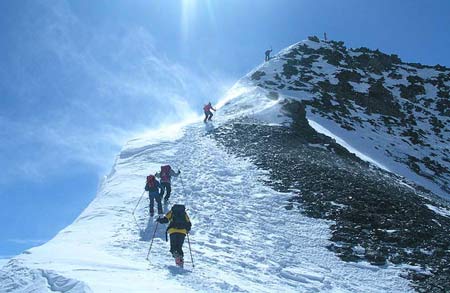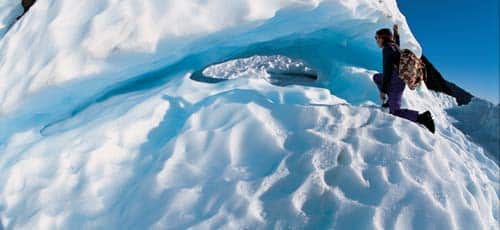by Jennifer Jordan
I came to this rather obscure subject of “women high altitude climbers” as any self-respecting journalist should — I wondered who the hell was writing their stories.
The problem was how women climbers in the rarefied world of high altitude mountains — those 14 peaks scattered through Nepal, India, China and Pakistan that stand above 26,000 feet — were described in books, articles and film. Even though engaged in an insanely difficult, demanding and deadly sport, these female athletes were often identified, not by their achievements or even their aspirations, but by what they looked and sounded like, what they wore, how much money they had, what “extravagances” they had brought on expeditions, and of course, if they left children at home to pursue their “selfish obsession” with high altitude. I wondered how a woman’s “body odor,” or her “harsh, almost nagging voice,” or her “cappuccino machine,” or her “ability to write a check of $60,000” or her “young toddlers she left at home” had anything to do with climbing a Himalayan mountain.

Meanwhile, their male counterparts were described as seasoned climbers should be: What Himalayan mountains they had previously climbed, whether they used bottled oxygen and high altitude Sherpas or went without, and climbed in the lighter, faster “alpine” style, and, whether their overall goal in the mountains was professional or personal.
Incensed by this double standard of reportage, to say nothing of its often snarky commentary on a woman’s expensive haircut or her expedition love life, I set out to determine whether, in fact, women high altitude climbers have two obstacles in approaching their Himalayan targets: the mountain at their feet and the men behind their backs.
Sadly, infuriatingly, the answer I found is a resounding yes, which may answer why women represent only about five percent of high altitude climbers. As one of the world’s most famous and talented rock climbers, Lynn Hill, said when I asked why she didn’t climb the Big Mountains (as the Himalayas are often called), “I don’t need to deal with the bullshit of base camp.”
Fair enough (and spot on), but it still begs the question; what about the women who do? And what do they suffer, both physically and mentally, to be competent players in the high altitude game?
The answer is – plenty. This odd, beguiling, terrible, wonderful, unspeakably gorgeous world is also among the deadliest arena on Earth. For kicks, I compared the death rate of high altitude climbing with skydiving and BASE jumping. In any given year, less than 2,000 people (and that is being generous) attempt one of the Himalayan peaks. And, any given year, there are anywhere between 20 and 30 deaths in those same mountains (here I am being conservative, again, to make a point.) That is an “attempt to death” ratio of 1.5 percent. In 2010, skydiving records show 21 deaths in an estimated 3,000,000 jumps – a death rate of 0.0007 percent. If skydiving were as deadly as high altitude climbing, the bodies would be dropping out of the sky like autumn leaves: 45,000 a year. BASE jumping’s death rate? In 2011, “only” one death for every 2,317 jumps. But if BASE jumping were as deadly as high altitude climbing, 30 times more people would die every year in their leaps off of tall objects.
Pushing the Body’s Limits
I reached out to climbers to find what it was that drew them to risk their lives in this sport with a place called the “Death Zone,” that magic mark above 25,000 feet in which the body cannot survive beyond days. Simply put, the body and brain suffocate from lack of air.
From the moment a climber ascends above 18,000 feet her body is no longer building muscle. Above 22,000 feet, the lack of atmospheric pressure to force oxygenated blood through the circulatory, respiratory, gastrointestinal and cerebral systems puts the body into mere survival mode. Wounds don’t heal, slower circulation threatens hands and feet with frostbite, chronic coughing can break ribs and often produces frothy, pink sputum, lips and fingernails can turn an unsettling blue or gray, thinking is muddled, coordination and balance are compromised, and although the climber feels lethargic and drowsy, restful sleep is nearly impossible.

Above 25,000 feet, it gets even worse. At that altitude, the body is in a race against death, slowly suffocating from a dangerous lack of oxygen and languid blood flow. Meanwhile, the heart and lungs are pumping furiously, trying to force enough oxygen through the blood to keep the body alive. Unfortunately, this “panting” throws off a lot of carbon dioxide, making the blood very alkaline. The kidneys compensate for the alkalinity by excreting bicarbonate, thus increasing urine production, which robs the body of even more liquids. Soon, the blood thickens to something resembling the consistency of house paint.
And don’t even get me started on what happens to the brain in its struggle to survive, not only with house-paint thick blood running through it, but with barely enough oxygen to keep a candle burning.
For all of this “sport,” men and women leave home, hearth, lovers, children, livelihood and every imaginable creature comfort, to spend weeks sitting at the foot of these beasts hoping that a window in the weather will open so that they can lace up their boots, fasten their harness, and climb into its awaiting jaws.
It was the question of “Why?” that drove me to trace their deadly footsteps. As I dug deeper and deeper, I learned their stories and, often, examined their deaths. But it wasn’t until I interviewed one of the survivors of the 1996 debacle on Everest, in which nine people died in a single storm, that I came face-to-face with a real killer: K2, the second highest mountain on earth.
Getting to Know the K2 Five
On a glorious afternoon in Aspen in the summer of 1998, Charlotte Fox and I sat on her porch overlooking the Rocky Mountains, sipping ice tea and talking mountains, expeditions, women and death. Charlotte, not only a survivor of Everest’s most infamous storm, she was, at the time, one of America’s few high altitude female contenders. She flipped through a climbing magazine, looking for an article she thought would interest me.
“Oh, look at this,” she said, rather casually, I thought in hindsight, “Chantal Mauduit just died climbing Dhauligiri. That means all of the women of K2 are dead.”
Two books, a documentary, and nearly 14 years later, I still cannot explain why I felt a total sea change come over my life. But I knew without question or hesitation, that I had to find out who these “women of K2” were, and how they lived and why they died.
| For women climbing the mountain prior to 2004, the death rate was 100 percent |
As I delved into K2’s history, I immediately came across a mind-numbing statistic. For women climbing the mountain prior to 2004, the death rate was 100 percent — five women had made the summit and five women had died in the process. I soon realized these heroic women and their tragic stories, when mentioned at all, were mere footnotes in the still very male world of high altitude climbing, a history written almost without exception by men.
What those male mountaineering writers missed entirely is that these five women — Wanda Rutkiewicz, Liliane Barrard, Julie Tullis, Chantal Mauduit and Alison Hargreaves — had many people in their lives: husbands and lovers, children and siblings, mothers and fathers, friends and adversaries, supporters and detractors. With every new person I found, every fact I learned, every controversy I unearthed, I scratched away at the veneer of their lives, learning things I sometimes had no right to know, talking with people who hadn’t spoken since the woman’s death, or since their love affair with her had ended. I spoke with families who hadn’t yet found closure, siblings who never had a chance to say good-bye, lovers who were unacknowledged, and children who were sad and confused at having played second fiddle to a monolith of rock and ice. Years after Alison Hargreaves died on K2, her father John Hargreaves, put his head in his hands and sobbed, remembering the little girl who climbed Ben Nevis in her saddle shoes and wool pea coat. Today, her son Tom, six when his mother was swept off the summit ridge to her death, aspires to be the first man to ascend K2 alone and in winter. Is it any wonder if he may feel compelled to stand in her last footsteps?
The women of K2 left behind a tapestry of grief because, even though each climber and her family knew the risks involved, when someone is actually lost, the hole is raw with unsaid words, unlived potential and unrealized dreams.
When I set out to write their biographies, I had no idea that these wonderful women would not only become part of my life, they would define it for years, in fact, changing it in every major way possible, from my marital status to where I live. They have become part of my fabric, and I am indebted to them for their courage, grace, wisdom, wit and sheer talent at the roof of the world. I am honored to have been the one who decided they deserved better than a footnote in the history of high altitude mountaineering and its unheralded heroes.
Jennifer Jordan is an award-winning author, filmmaker, and screenwriter, as well as a journalist, broadcast producer, radio and television news anchor, voice-over/narration talent and motivational speaker. She wrote “Savage Summit” and “Last Man on the Mountain,” and wrote and produced the documentaries “Kick Like a Girl,” “Boys of Bonneville” and “Women of K2.”
Also see From Our Archives: Related Stories on Girls, Women, Sports in this edition of On The Issues Magazine.
See Films Lag in Sharing The Women’s Game by Ariel Dougherty in this edition of On The Issues Magazine.
Read the Cafe for new and updated stories.
